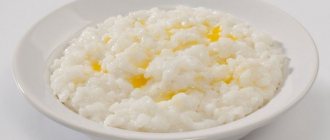Introduction of complementary foods
In the first months, the baby’s body grows very actively, and one animal protein is not enough for it - at a certain stage there is a need for dietary fats and carbohydrates, which can be provided by plant foods. The first introduction begins with fruit juices, which do not replace feeding, but only complement it.
Baby's first feeding
Closer to six months, vegetables already appear in the baby’s diet - an excellent source of fiber, pectins and minerals that help improve gastrointestinal motility. When introducing vegetables necessary for the first complementary feeding, you need to follow some rules.
- At this moment, the baby should be absolutely healthy, his living conditions have not changed, his teeth are not cutting, he has not received vaccinations the day before, and there is no bowel disorder.
- Familiarization with a new product always begins with small doses, giving it to the baby with a teaspoon before feeding (preferably before the second). Then gradually increase the amount of vegetable puree, eventually replacing one of the breastfeedings with it.
- A new vegetable is introduced into the diet after the child’s body gets used to the previous one (the gap is approximately 2-3 weeks). Vegetables for the first feeding, the scheme is described further in the article.
Having switched to a vegetable menu, the mother should observe the baby’s behavior during these periods and the state of his body.
Rules for first feeding
Rules for first feeding
Babies grow and mature every day, and at a certain point there comes a period when milk nutrition is no longer enough for him and it is necessary to introduce complementary foods.
Lure
- this is food of animal or plant origin, which gradually replaces breast milk (infant formula) and helps transfer the child to an “adult type” diet. Complementary feeding satisfies the child's increased needs for food ingredients, energy, vitamins and minerals; in addition, timely complementary feeding contributes to the formation of the chewing apparatus and adequate taste habits.
It is optimal to start introducing complementary foods between 4-6 months. If your baby is exclusively breastfed, do not rush to introduce complementary foods early, because... this may reduce breast milk production. The timing and order of introducing complementary foods must be agreed with the pediatrician.
There are certain signs that a child is ready to introduce complementary foods:
• extinction of the reflex to “pushing out” with the tongue with a well-coordinated reflex of swallowing food;
• the child's readiness to chew;
• completed or current teething;
• sitting independently or with little support;
• the ability to express attitudes towards food with emotions and gestures;
• maturity of the gastrointestinal tract functions.
Basic rules for introducing complementary foods:
• the child must be healthy. Complementary feeding should not be introduced in case of acute illnesses, during travel, moving, on the eve of vaccination or immediately after it for 3-5 days;
• complementary foods are given at the beginning of feeding, and then the baby is supplemented with milk;
• start with small volumes (1-2 teaspoons), gradually increasing the volume over several days to the age norm and, accordingly, reducing the volume of milk feed during this feeding;
• a one-component, low-allergenic and homogeneous in consistency dish as the first complementary food, and then gradually complicating the composition (two-component, multi-component) and expanding the range;
• introduce new foods into the child’s diet in the first half of the day, so that you can monitor the child’s initial reaction (condition of the skin, digestion, appetite, etc.) until the evening;
• complementary foods are given warm, from a spoon. Initial refusal to accept a new taste is a common occurrence; it is necessary to patiently accustom the child to the new taste. For most children, it takes at least 8-10, and sometimes 15, tries to accept a new taste. Children also have the right to their opinion in this matter. If the baby is not in the mood today, do not force feed him, maybe he will like this product tomorrow or in a week;
• a new type of complementary food can be introduced after complete adaptation to the previous one. Two new products cannot be introduced at the same time (including simultaneously introducing a new milk formula and introducing new complementary foods).
Homemade complementary foods or commercially produced baby food?
Leading pediatricians around the world recommend industrially produced food, because... they have a number of undeniable advantages:
• tested high quality raw materials and safe for the baby. Use of varieties suitable for baby food (for example, fruits with low acidity to prevent irritation of the immature mucous membrane of the baby's gastrointestinal tract);
• guaranteed chemical and microbiological safety (compliance with SanPiN, GOST);
• guaranteed and stable chemical composition corresponding to age-related characteristics of metabolism and digestion;
• consistency and degree of grinding, corresponding to the age characteristics of the child’s chewing apparatus and digestive system;
• a diverse and seasonally independent range of raw materials used in the production of complementary foods (unavailable at home types of vegetables, fruits, meat, hard-to-cook cereals - corn, rye, barley and mixtures of several cereals, etc.).
Now let's talk about what complementary foods you should start with.
What complementary foods should I start with?
Currently, leading pediatricians recommend so-called energy-dense complementary foods as the first complementary foods. This is due to the small volume of the stomach, so that with a small amount of food it satisfies the child’s needs for nutrients and energy. Therefore, complementary feeding products must have a high energy value (density) (more than 70 kcal/100 ml) and a high nutrient content, since they are given to the child in a limited volume.
An energy-dense product recommended as the first complementary food is porridge, preferably industrially produced instant porridges enriched with iron, calcium, zinc, iodine, which do not require cooking. The advantages of industrially produced cereals are also the safety of raw materials and the final product; stability of the composition, providing 20-30% of children’s daily needs for nutrients and energy. Porridge replaces milk feeding, usually the second after morning feeding with breast milk or formula. Dairy-free cereals can be diluted with breast milk or the formula that the child receives. Porridge is introduced into the diet no earlier than 4 months and no later than 6 months of life.
Which porridge should you choose first?
Historically, our mothers and grandmothers widely used affordable and quick-to-prepare semolina porridge. However, gluten-containing cereals (semolina, oatmeal, wheat) can provoke food allergies and intestinal disorders. Also, semolina is poor in vitamins, minerals, and also contributes to excess weight gain. Gluten-free cereals are currently recommended as the first cereal - buckwheat, rice, corn. For children with unstable stool, rice porridge may be recommended first. On the contrary, a child with a tendency to constipation should be given buckwheat porridge, rich in dietary fiber.
Start with dairy-free, low-allergenic recipes for these cereals,
containing one type of cereal and vitamins.
Usually porridge replaces the morning feeding at 10 am.
First, you give the child 1-2 teaspoons of porridge, then supplement with milk. If the porridge is well tolerated, the next day increase its volume by another 1-2 teaspoons. And so every day you will increase the volume of porridge, and the volume of milk food that the child eats will correspondingly decrease until you completely replace this feeding with porridge, bringing the volume to 140 - 150g. While introducing a new type of product, stay with one type of cereal. When the child adapts to the porridge and you bring the volume up to the daily requirement, you can try another type - rice, and then corn. Once you are sure that your baby tolerates these cereals well, you can use milk porridges made from these types of grains and their combinations, as well as with the addition of fruit. By 6.5-7 months, the child can be given porridges made from gluten-containing cereals (oatmeal, wheat, millet) - both from one type of cereal and multigrain. From 7 months
You can give porridge to your baby 2 times a day - morning and evening, especially if the child is not gaining weight well. In order not to overload your child with grain-based complementary foods, use milk porridge in the morning, and in the evening offer multi-grain or oatmeal Semper. Welling is a liquid drinking porridge based on an adapted milk formula, hearty and nutritious, which you can give to your baby from a bottle or drinking bowl.
The introduction of complementary foods is accompanied by an increased risk of intestinal infections. Therefore, complementary foods enriched with components that help maintain the growth of friendly intestinal microflora are relevant.
The second complementary food, after 5 - 5.5 months and, as a rule, 2 weeks after the introduction of porridge, is usually vegetable puree. At first, it is better to use puree made from one type of vegetable, for example, zucchini, cauliflower, broccoli or potatoes, gradually moving on to expanding the range (carrots, pumpkin, Brussels sprouts, etc.). Pumpkin, various varieties of cabbage (white cabbage, cauliflower, broccoli), zucchini contain less carbohydrates than other vegetables, so they can be used in the diet of overweight children. When preparing puree at home, vegetables are steamed or in a small amount of water until tender, without salt (for the correct formation of taste habits), vegetable oil is added in an amount of 3%.
It is preferable to use ready-made baby food in a jar. According to the degree of grinding, industrially produced purees can be homogenized for children 4-6 months old
;
pureed for children from 6 to 9 months;
coarsely ground for children
from 9 to 12 months.
Introduce your child to vegetables gradually - on the first day, give 1-2 teaspoons of vegetables, then supplement your baby with milk. It is advisable to start with one-component purees based on dietary varieties of cabbage (cauliflower, broccoli), zucchini, and potatoes. If tolerated well, increase the amount of vegetable puree every day, and reduce the amount of dairy food accordingly. This way, you will increase the volume of vegetable puree to 120-130 g. Give vegetables to your baby at lunchtime, from a spoon, warm - heated to 37ºC. When the baby adapts to these types of vegetables, you can add a small amount of potato puree to
.
Thus, the child will receive a two-component puree. Then offer your baby a ready-made two-component puree, for example, “Zucchini with potatoes.”
You can give pumpkin - it is well absorbed and tolerated by small children, and its dietary fiber gently regulates intestinal activity.
Meat, starting with meat puree, is introduced from 6 to 7 months.
This is
the third
complementary food. According to the individual recommendation of a pediatrician, premature babies, children with anemia, insufficient weight gain, as well as those with a tendency to allergies, meat can be prescribed as early as 5 months. Meat is essential. It is a source of complete protein and many minerals and trace elements necessary for harmonious development, especially highly digestible heme iron. Dietary types of meat are suitable for baby food - turkey, rabbit, lean pork, which are the first of the recommended types of meat. Then you can use horse meat purees. All these varieties are also recommended for children with allergies. In this case, of course, the individual tolerance of the product is also taken into account. Beef, veal, chicken can also be used for baby food, provided they are tolerated. Puree with the addition of offal (liver, heart, tongue) is used in the diet of children over 7 months of age no more than 2 times a week.
To introduce meat, add a small amount of puree containing meat (meat-vegetable or meat) to the vegetable puree already familiar to the baby, for example, to 135g of cauliflower puree, add a few teaspoons of “Turkey” or “Rabbit”
.
You can also use meatballs from Semper, Frutonyan and other brands
, which have a high meat content and, when combined with vegetable purees, serve as a complete lunch for the baby.
Provided that it is well tolerated, increase the volume of meat and vegetable puree every day, and reduce the amount of vegetables. Thus, you will combine vegetables and a meat and vegetable dish for several days until you completely switch the child to meat and vegetable puree. Now meat and vegetable puree will be included in the child’s diet every day at lunchtime in a total amount of 160 - 180 g, and by 8 months - up to 190 - 200 g. Ready-made canned food for baby food is more preferable:
they are better digestible, have optimal safety parameters and correspond to the capabilities of the baby’s immature digestive tract.
Meat, meat-vegetable (or they are also called meat-vegetable) and vegetable-meat canned food differ in the content of meat in them and in the degree of grinding. Meat makes up at least 50%
in canned meat, at least
30%
in canned meat and vegetables, and no more than 10-15% in canned meat and vegetable products. Based on the degree of grinding, these canned foods are differentiated depending on the age of the child and are divided into canned food for three stages (stages) of development:
I stage
- for children 6-8 months (homogenized),
II stage
– 8-12 months (puree),
III stage
- for children over one year old (coarsely ground).
And yet, all children are individual, so the scheme for introducing complementary foods may change:
- if you are underweight or have frequent stools, porridge is the most optimal first complementary food;
- If you are overweight, constipated, or have signs of rickets, vegetable puree is recommended as the first complementary food.
- At the same time, meat is introduced after it. In this case, porridge is introduced as the third complementary food;
- for children with a hemoglobin level below 115 g/l, meat is introduced as a second complementary food 10-14 days after porridge, and then vegetable puree is introduced;
- the time of introduction and type of complementary foods for children at risk of developing allergies is determined on an individual basis.
- Publication date: 03/21/2018
- Nutrition issues
Adequate adaptation
All babies perceive innovation differently. Therefore, it is so important to take into account the body’s perception of vegetables introduced into complementary foods. The following criteria will tell you how well the product fits the bill.
- The toddler is actively gaining weight and growing according to the norms for his age.
- The baby maintains a good appetite.
- The child is cheerful, behaves calmly and sleeps normally.
- Normal bowel movements are observed, with no signs of unprocessed food debris. The stool can be fully formed or half formed, but should not have an unpleasant odor.
- There are no allergic reactions to vegetable baits, where the first sign is skin rashes or redness.
If the baby’s neuropsychic development remains normal, complementary feeding can be continued, introducing new vegetables according to the scheme.
Cooking porridge
To prepare porridge at home, you need to grind the cereal to flour, and then cook it in water without adding sugar or salt. Modern recipes for complementary feeding cereals recommend choosing low-allergenic, gluten-free cereals: rice, corn or buckwheat.
Rules for preparing porridge:
- Maintain the proportions of water and ground cereal.
- You should not add water during the cooking process.
- Do not stir rice and buckwheat during cooking.
The first porridge for your baby can be very liquid - a teaspoon of ground cereal flour per 100 ml of water, but after a couple of weeks you can double the volume of cereal. If desired, you can add fruit puree to the porridge.
Place the ground cereal strictly in boiling water, and then leave it to swell so that this does not happen in the baby’s stomach.
Which vegetable should be introduced first into complementary foods?
There are many different opinions regarding which product you should start baiting with. There is no traditional classic list that must be strictly adhered to. Here everything should be based on an individual approach, but taking into account some points.
Which vegetables should be introduced first in complementary feeding?
- The vegetables that the expectant mother ate are already a little familiar to the baby from the period of intrauterine development (or rather, their components supplied to the fetus with the blood). They can be taken as a basic basis.
- Vegetables for the first feeding should not be exotic - only those that are traditional for the region where the baby’s family lives.
- The color of the product matters - bright ones should be left for later, introducing a white or green vegetable one of the first.
- You should not choose a thick-skinned fruit as your first plant product. Even if the skin is completely removed, the intestines may react inadequately to such complementary foods.
Have you started introducing your baby to the first vegetable, and he developed an allergy? Don't immediately look for a replacement. It is better to wait a few days and try again with the same product.
When to introduce water into a child's diet?
Experts recommend starting to give children water immediately after introducing complementary foods. This is due to changes in the body that occur while getting used to a new diet. If previously the baby consumed more breast milk, now his body may experience a lack of fluid.
At the same time, do not hesitate to discuss this topic with your pediatrician. Based on the child’s condition and the speed of his development, he can determine how much liquid should be in his diet at this stage.
Approximate list of first vegetables
Based on the above, a mother can easily create her baby’s diet for each month. Those who find it difficult to do this can use the table below.
List of vegetables for complementary feeding
| Baby's age | Vegetables introduced into the diet | The shape of the puree at this stage |
| 4.5 – 5 months | Zucchini, cauliflower, broccoli | Finely ground liquid puree without lumps |
| 5 – 5.5 months | Potatoes, carrots | The same |
| 5.5 – 6 months | Pumpkin, white cabbage, beets | Semi-liquid form without lumps |
| 6 months | Tomato | Puree |
| 7 months | Green pea | Coarse puree |
The table shows which vegetables to introduce into complementary foods first. This list is only approximate - some mothers, instead of zucchini, immediately start with cabbage. In this situation, you will need to take into account that this product is a laxative, so it should be handled with caution. Although, if the baby suffers from constipation, this step may become rational.
The list under consideration should not be perceived as replacing one vegetable product with another, based on the child’s age - they should all be present in the diet. The more vegetables are introduced, the more varied the diet.
How to properly prepare meals for the first feeding
If you have decided to abandon ready-made baby food in favor of homemade complementary foods, you should approach it with the utmost responsibility. In this case, it is recommended to abandon the usual boiling of vegetables in favor of steaming them, which will preserve a much larger amount of nutrients. After the vegetables have completely softened, they must be pureed without adding salt or oil.
Too thick puree is diluted with the remaining broth, so do not rush to dispose of it.
Fruit puree should be prepared without the peel, using raw or steamed fruit pulp (preferable at the first stage). Cereal porridges are usually sold in the form of a dry mixture, which is simply diluted with boiled water to the desired consistency. Cottage cheese and meat must be ground or pureed using a blender. When preparing soups, you should also ensure their uniform consistency.
See also:
How to teach a 6-8 month old child to crawl on all fours?











